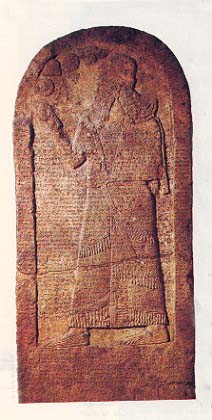Image Details

British Museum
Discovered at Kurkh on the Tigris River in southeastern Turkey, this 7.2-foot-high stela depicts Shalmaneser III facing the symbols of the gods Assur (the winged disk), Ishtar (the star), Anu (the horned miter) and Sin (the disk and crescent), and contains 102 lines of cuneiform text giving an account of the first six years of Shalmaneser’s reign. The text describes the battle of Qarqar, where Shalmaneser defeated a coalition of seacoast kings in 853 B.C.E., a coalition including “Ahab the Israelite,” who made the largest contribution of 10,000 foot soldiers and 2,000 chariots. This reference deepens the enigma of Shalmaneser’s identification of Jehu as “son of Omri” on the Black Obelisk. The Assyrians knew about Ahab and referred to him as an “Israelite”—not as “son of Omri,” which in fact he was. Therefore, author Schneider argues, “son of Omri” probably was not a general phrase for Israelite.
